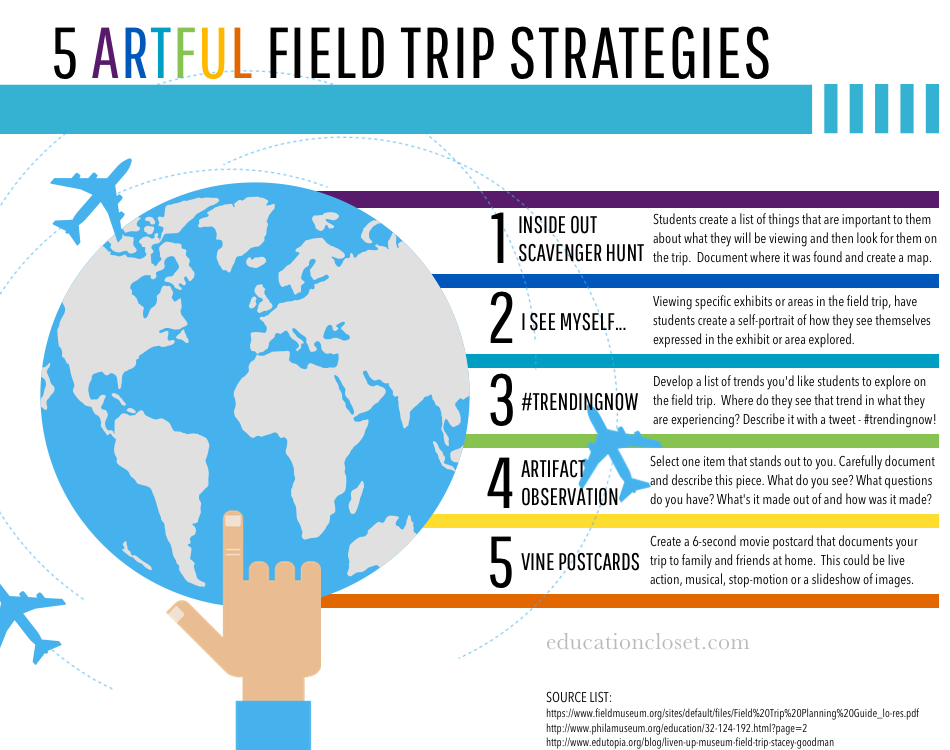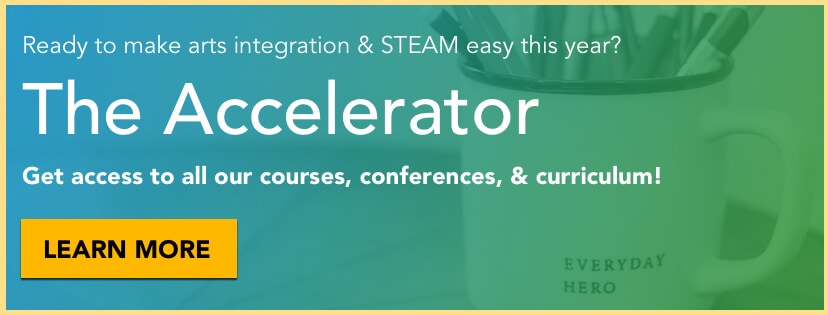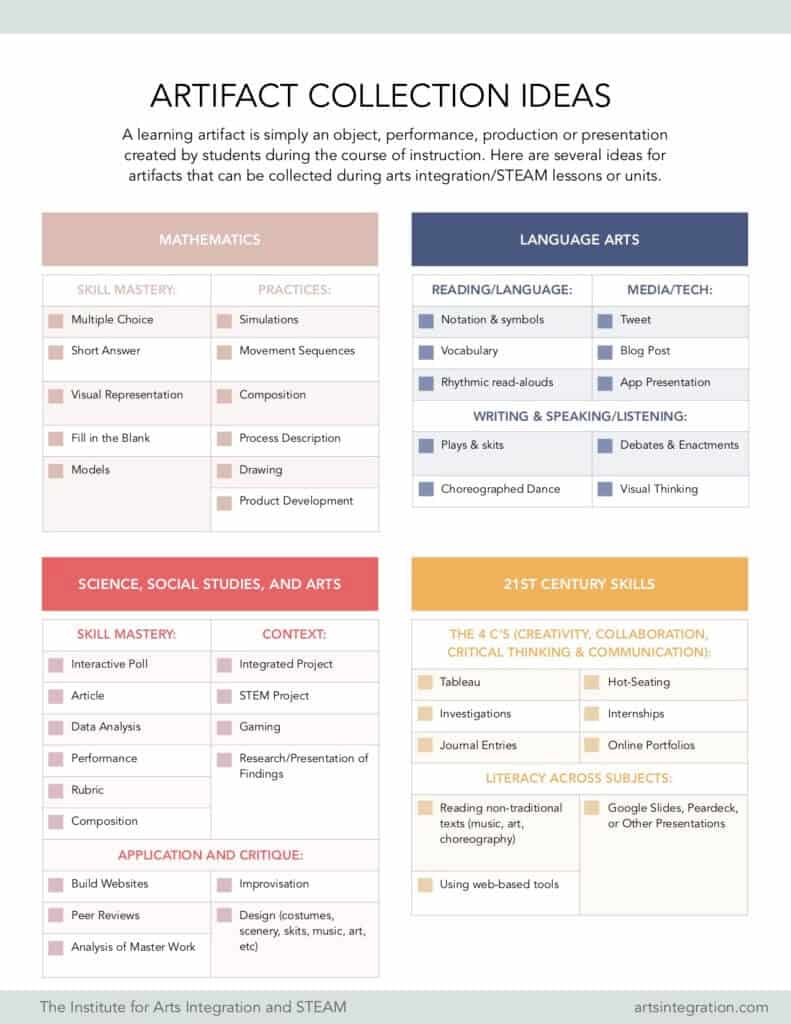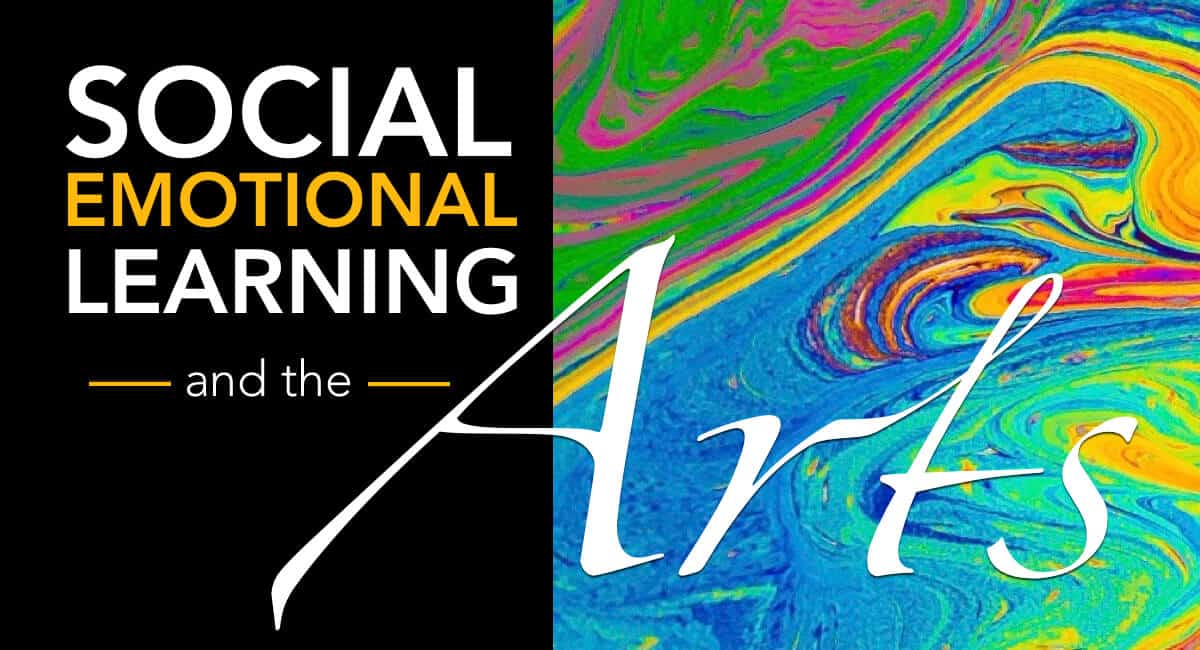Creative thinking activities can help our students deepen their understanding of interconnected topics, explore problems, and collaborate on solutions. The activities in this guide are examples of ways you can begin to bring more creativity into your classroom – no matter what you teach.
Why Creative Thinking and How Do We Cultivate It?
Creative thinking and creative mindsets are two sides of the same coin. Creative thinking encompasses skills and processes that lead students toward a creative mindset. A creative mindset is a practice of leveraging creativity to continually grow and evolve. Think of a creative mindset as a muscle and creative thinking as the strategies needed to build that creative muscle.
When this happens, creative thinking becomes a natural habit that opens us to future possibilities and opportunities. So it’s essential to promote creative thinking in our classrooms. Now, more than ever, we are pushing the boundaries of the known. We need learners who aren’t afraid to ask questions, take thoughtful risks, and engage in productive dialogue. This isn’t possible with bubble tests and right/wrong test questions. So cultivating creative thinking is imperative to our future.
Cultivating creative thinking can be simple. It happens in the daily habits, instructional strategies, and creative activities we explore with students. In this guide, we’ll be offering several creative thinking strategies as examples, but there are so many additional opportunities to explore this pathway. Start with these ideas and then expand on them over time to truly see creativity come alive with your students.
1×5 Creative Thinking Strategy
The 1×5 strategy is a creative thinking activity that provides 1 object or idea and has students alter it 1 time for 5 rotations. So, you could move students into groups of 5 and provide each group with an object or an idea. Each person in the group must add or change one thing about the object or idea. You rotate until each person in the group has had a turn.
WHEN TO USE IT
You can use this strategy in a variety of ways. I’ve found it to be very effective as a warm-up or as a way to get traditionally quiet students an opportunity to add their thoughts and opinions to a project. I’ve also found that it’s helpful for clarifying and narrowing a big idea into a more refined, cohesive thought.
You can use this for:
- Prototyping a design
- Project how-to’s
- Idea brainstorming
- Creating a musical, dance, or visual art composition
- Reworking a piece of writing
- Exploring math problem variations
- Considering an alternate ending to historical events (what would have happened if…)
To make it even easier, use the above a downloadable strategy card in your next lesson!

DOWNLOAD THIS STRATEGY CARD PDF
Creating a classroom museum exhibit can be an effective tool for arts integration. Museum lesson plans can be a powerful way for students to synthesize information, make content connections, demonstrate deep understanding of a topic, and practice speaking, listening, and presentation skills. Here are some ways to integrate the arts through a museum experience in your classroom…
Museum Procedures
- Museum Labels (Tags): There are a few types of labels/tags students can create to identify and provide information about parts of their exhibit as well as individual pieces. An introduction label should talk about the main idea of the exhibit. A section label can be used to identify topics within the exhibit. Finally, an object label describes the individual object or piece of art. This label typically gives the title of the piece, the date and place of creation, and the materials of the object. (Click here for information on creating classroom museum labels. In addition to other educational activities related to museum labels.) This procedure can be used for any piece of artwork created in an arts-integrated museum lesson plan.
- Museum Docents: Having students act as museum docents, or tour guides, is a great way to have them demonstrate what they know. All while, practicing those speaking and listening standards.
- Artist Statements and QR Codes: Have students record artist statements, and upload them a podcast or website. Display a QR code next to each piece. Include the museum label, so viewers can scan to access these recordings.
Exhibit Ideas
- Nature Displays: Students collect items from nature, based on a theme or topic of study. (Either collected from a nature walk, or brought from home). Have students display these items in a collage, and label them using classroom museum tags.
- Lit Exhibit: Have students create an exhibit of items related to a piece of literature. These items can connect to characters, setting, and plot. Students should create museum tags for these items. Then, be able to guide visitors through the exhibit as a docent. Students can also write about their item in an essay or journal entry.
- Historical Exhibit: Have students curate artifacts related to a social studies topic (historical or cultural). Students can include music, visual art, videos, digital media, information about important individuals from the time/culture, and cultural/historical items in their exhibit. Artifacts should be catalogued and given museum tags. And, students should be able to act as a docent to visitors to the classroom exhibit.
- Geometric Art: Have students create a piece of art incorporating geometric concepts (see the work of Mondrian). Students should create classroom museum tags for these pieces. They should be able to act as a docent, explaining the mathematical process that went into the creation of their artwork.
- Wax Museum: This is a familiar strategy. A wax museum requires students to research a historical figure or a character from a piece of literature. Students dress as that character, and prepare a monologue or written statement to be shared with visitors to the classroom museum. Additionally, they could take this a step further by providing a list of questions or topics for discussion that can be brought up to each character, students should respond in character, making the museum experience more interactive and giving students an opportunity to practice speaking, listening, and presentation skills.
Creating Learning Centers
How can you use a learning center for creative thinking activities? Once you have identified the purpose of the station activities (to build background knowledge for a topic or a theme, to explore several aspects of the current topic or theme, or to help students review for a unit of study) try to create one or more stations which focuses in an art form.
For example, in a seventh-grade social studies classroom starting a unit on Russia, students might visit multiple centers to build background knowledge on traditional Russian culture. In two visual arts-focused centers, students could view examples of Russian architecture at one, and handle cultural artifacts in another (such as Matryoshka dolls and Pysanky eggs).
In this example, students can describe, analyze, and draw buildings and artifacts by focusing in on the elements of shape, texture, pattern, and color. They can watch video clips of traditional Russian dances and identify the most prominent elements of dance before trying a few steps. They can listen to examples of traditional Russian folk music and identified the tempo, texture and dynamics using an Artful Thinking routine, I Hear, I Think, I Wonder.
You could also choose to create arts-focused learning centers which, allow students to explore each arts area in depth. Consider these examples:
VISUAL ART
An arts centers visual art can be fairly open-ended, depending on what kind of access you have to materials. A visual classroom art area can serve as a place where students can independently express their understanding of a concept through any form of visual art that is accessible to them. For that reason, the intention can remain consistent regardless of the types of materials and forms of visual art that can be accessed by the student. This classroom art area can be a place where students doodle, create works of visual art, study works of visual art to unpack themes, plots, characters, and data, and/or create exhibits to demonstrate an understanding of units of study.
The Setup
Again, the way this classroom art area is set up is dependent completely on the types of materials you have access to. You can include paints, pastels, pencils, chalk, markers, clay, and other materials for the creation of works of art. You can also include collections of artworks which students can study and unpack. Depending on what your students are studying, you can include works that are related to a theme or unit of study. You can also allow students to curate artifacts to create exhibits in this space, so your classroom art area could just be an open space for exhibits.
Activities
Students can engage in “reading” art in this center (see the See, Think, Wonder strategy). Students can also use works of art as a writing prompt, or as a prompt for their own visual artwork (see the I Spy strategy). Students can create artistic visualizations of data in science or math (see Creating Artistic Visualizations of Data). Students can create works of art in the classroom to depict a scene, embody a character, or convey a theme from a literary work. Students can curate artifacts related to a unit of study in social studies or science or related to a literary work and use this space as a classroom exhibit. The possibilities are endless!
Materials
- Paint
- Pastels
- Chalk
- Pencils
- Markers/crayons
- Clay
- Works of visual art (see
- Elements of a Visual Arts poster
DRAMA
Your drama center should be a place where your students can think creatively to bring an element of narrative to concepts and ideas being learned, and a place to bring narrative to life. Drama arts centers can stimulate creative storytelling, problem-solving, collaboration, and communication.
The Setup
Students might use this center as a place to bring stories and characters to life, to retell known stories, or to create and act out original works. You may want to include tubs of costumes, props, and minimal pieces of “scenery” for students to help bring their works to fruition. You may also include instruments so that students can create “sound stories” or sound effects to amplify their work. You might provide a general rubric for dramatic performance, including elements such as voice, facial expression, and movement, so that other students might provide feedback or a student might be able to self-assess their own performance.
Activities
Students may choose to utilize this center to create new works to demonstrate a concept or unit of study (i.e., students may write a script about a historical event to demonstrate their understanding). They may use this center as a Readers’ Theatre to bring known works to life. You may include lists of vocabulary words and have students pantomime them to demonstrate understanding. Students might conduct panels or interviews as characters from history or literature in this center. Basically, you can set up materials from any unit of study within this center and let students creatively explore how to bring it to life on stage.
Materials
- Puppets
- Costumes
- Props
- Elements of Drama poster
- Reader’s Theatre scripts
- Musical instruments
DANCE
So many of our students are kinesthetic learners, and allowing students an opportunity to explore concepts in a kinesthetic manner. Students can connect concepts learned through visual and auditory means by utilizing a more “hands-on,” bodily approach, strengthening those connections, increasing comprehension and retention.
The Setup
All you really need for this center is some open space, some music, and a few resources. You might provide a general rubric for Arts Centers Dance performance so that other students might provide feedback or a student might be able to self-assess their own performance or choreography. You might include props such as ribbons or scarves to add a little drama to choreography. Finally, you might include dance or movement cards to allow students a little assistance in sequencing their own choreography, including levels, pathways, and movements.
Activities
Students might create tableaus or sequences related to a story, an image, or a historical event. Students may choreograph cycles (life cycles, the rock cycle, the water cycle, etc.). If you’re studying geometric concepts, students may create movements to demonstrate their understanding of shapes, perimeter, etc. Students may create dances to convey the meaning of vocabulary word, or they may use movement to communicate emotions and other, more subjective, concepts.
Materials:
- Stereo
- Musical Selections
- Dance/movement cards
- Rubrics related to body, energy, space, time, sequencing
- Props (scarves, ribbons)
- Elements of Dance poster
MEDIA ARTS
The idea behind a media arts studio is to allow students a space to learn to employ their creative skills to develop digital works of art to communicate a message. This skill is incredibly important in our 21st-century classrooms, as this is the type of workforce our young students will be entering someday- a workforce we can’t predict. It is essential that we instill a sense of independence in creating digital and media works in our young students to prepare them for a still-undefined field of jobs and careers.
The Setup
A media arts center is a bit more resource-intensive. Computer, laptops, tablets, printers, 3D printers, etc.- the bottom line can really add up. You can adjust the menu of activities in your media arts center to reflect the possibilities you have at your disposal. In the event that you are lacking resources, look into options for securing grants and donations to build up your media arts makerspace.
Activities
Depending on the materials and equipment at your disposal, the possibilities are endless. Using audio applications, students can create podcasts to highlight their understanding of a unit of study or sound stories to enhance an original written work or a known story. Using video applications, students may create movie trailers or short movies to highlight a process-based learning experience or to film an original script based on a unit of study. Students may design posters, flyers, or informational brochures. The activities are completely flexible based upon your equipment and your comfort level in facilitating such activities.
Materials
- Computers/laptops
- Printers
- 3D printers
- iPads/tablets
- Sound software such as Audacity and GarageBand
- Video software such as iMovie
- Elements of Design poster
References for Arts Center Media Arts Activities:
Teaching Elementary Students to Be Digital Media and Technology Experts
MUSIC
Your classroom music centers might have one of many different intentions, which will shift the focus of how you set up your center. Your center might focus in on listening activities. It might focus in on an exploration of instruments and tools of music. It may also focus on composition using software and sound tools such as GarageBand and Audacity.
The Setup
Depending on the intention of your music center, you may or may not need a lot of space. A classroom music center that is dedicated to listening will really only require some personal listening devices, such as iPods, headphones, and some reference materials (listening logs, instruments of the orchestra flashcards, elements of music poster, etc.).
You may, however, depending on your resources and the intention of your center, want to have some instruments, such as a drum, a pitched instrument like a glockenspiel or xylophone, a keyboard, or mouthpieces from wind instruments. Finally, you may want to have some music composition software, such as GarageBand, which would allow students to create their own works of music on a laptop or iPad. Because a classroom arts center can be resource-intensive and costly to set up, depending on your intention, ask for donations of old instruments, iPods, etc., or write a grant for the materials you need.
The Activities
Depending on the lesson or concept being explored, students can listen to music within the theme. For example, if students are learning about space, use Gustav Holst’s The Planets as a writing prompt). Students can compose pieces to convey elements of drama, to tell a story, to provide a soundtrack for a work, etc. If you have instruments in your center, allow students to explore the science of sound in these instruments. Your classroom music center can always be a place students choose to go with any free exploration time to engage in listening and writing prompts, to creatively compose “just because,” or to feel connected to content through the power of music.
The Materials
- Personal listening devices
- Headphones
- Listening logs or glyphs (check out TeacherPayTeachers.com for logs/glyphs appropriate for your grade/content)
- Elements of Music poster
- Instruments (drums, glockenspiels/xylophones, keyboard, mouthpieces from wind instruments, etc.)
Take an Artful Field Trip
Taking a field trip can absolutely cultivate and expand students’ creative thinking skills. Almost any field trip can become an artful learning experience! Obviously, if we go to a museum or the symphony, we’re completely immersed in the arts. But what about if you travel to (or virtually view) a historic site? Or if you take a trip to the local library? Here are 5 strategies you can use to integrate the arts whenever you’re taking a trip:

DOWNLOAD THIS PDF
Inside Out Scavenger Hunt
Instead of providing students with a list to find on your travels, have them create a list of things that they feel are important about what they will be viewing and then seek them out on the trip. Students can document where it was found and then create a map sharing each “treasure” that they discovered.
I see myself…
When viewing specific exhibits or areas in the field trip, have students create a self-portrait of how they see themselves expressed in the exhibit or the area explored.
#TrendingNow
Develop a list of trends or themes you’d like students to explore on the field trip. Where do they see that trend in what they are experiencing? Create a tweet to describe that using the hashtag #trendingnow. Just a note: students don’t actually have to tweet it out. They can put it on a piece of paper and use “paper tweets” or post-it notes in the classroom.
Artifact Observation
Ask students to select one piece or exhibit that stands out to them. Carefully document and describe this piece. Describe what they see, what questions they have, what it’s made out of, and how it was made, and who made and used it. Students can then sketch it out or create a frozen picture of it as a tableau with their group while someone takes a picture.
“TikTok” Postcards
Students create a 6-second movie postcard that documents their field trip experience to friends and family at home. It could be live-action, musical, stop-motion animation, or a slideshow of images – the choices are endless! Instead of posting to social media, have students share their “TikTok” showcase via Flipgrid or SeeSaw.
If you are not able to physically visit a museum. And, you need ideas and resources for arts integration lessons. You can make a point of visiting them online. Most museums have websites where you can search, access and often download images. (The National Gallery of Art, any of the Smithsonian museums and the Walters Art Museum, for example, have digitized their collections and allow you to download artwork as .jpeg files and save them on your own computers.) What is even better is that many art museums have developed excellent resources and lessons for integrating content curriculum with visual arts. You can find lessons, interactive sites and teaching kits for integrating art in science, math, social studies, and language arts classrooms.
Here are some go-to museum sites to find content specific creative thinking activities, ideas and resources:
A series of lesson plans arranged in thematic units with grade-specific activities focusing on a single work that can be completed in 1-2 periods.
North Carolina Museum of Art (NC)
An amazing online concept map tool for teachers to create arts-integrated lesson plans using selected museum artwork while connecting to twelve concepts i.e. environment, identity, collaboration, conflict.
Philadelphia Museum of Art (PA)
Many downloadable lesson plans as well as excellent online teaching kits. Looking to Write, Writing to Look is a wonderful kit for Common Core writing connections.
Smithsonian American Art Museum (DC)
Excellent downloadable teacher guides and materials for many topics, grade levels, and standards for a variety of content areas but mostly social studies, history, and language arts.
Among the many resources for teachers and classrooms are their interactive sites based on themes such as Integrating the Arts: China as well as a bank of content integrated lesson plans. My newest favorite is their Common Core Connections, a series of arts-integrated activities connecting to Common Core Math (and Math Practices) and ELA to pieces from the museum.
Learning Artifacts for Assessing Creative Thinking
Many educators are concerned that it will be difficult to assess creative thinking skills. However, using learning artifacts can be a simple way to easily check for understanding.
A learning artifact is simply an object, performance, production or presentation created by students during the course of instruction. Here are several ideas for artifacts that can be collected during arts integration/STEAM lessons or units.
DOWNLOAD A PDF OF THIS LIST
Final Notes
As you begin considering creative thinking activities and strategies, be sure to reflect on the learning needs of the students in your class. Some students may prefer hands-on activities while others would like to take time analyzing and exploring different mediums. The activities shared in this guide address all kinds of learning preferences, so you can quickly get up and running with your students.
No matter which activities you choose, remember to embrace the joy that comes with creative learning experiences. There’s just nothing else like it when we teach.






